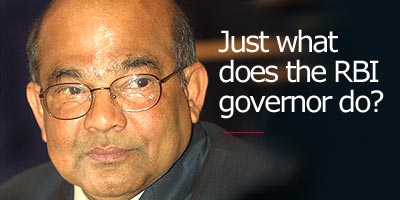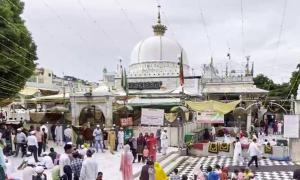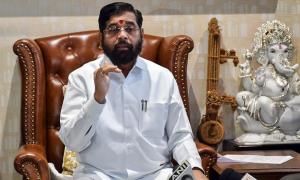
Yaga Venugopal Reddy will take over as Reserve Bank of India Governor from outgoing RBI chief Bimal Jalan on Saturday. Dr Reddy was RBI Deputy Governor in charge of Monetary Policy. He was also Executive Director at the International Monetary Fund just before begin selected to lead the RBI.
Jalan, who has been nominated to the Rajya Sabha, had a highly successful stint of almost six years at the RBI's helm. Along with Reddy, he steered India away from the Asian financial crisis. It was during his tenure that the country's foreign exchange reserves surged to a record $85.5 billion and interest rates dipped to three-decade lows.
With India emerging as a major economic force in the past decade, any changes at the RBI -- which formulates, implements and monitors the monetary policy and regulates the entire banking system of the country -- is looked upon with interest and awe.
The Reserve Bank, which is the central banking institution of India, was established on April 1, 1935 in accordance with the provisions of the Reserve Bank of India Act, 1934. Its central office is at Mumbai, has 22 regional offices, most of them in state capitals. The Reserve Bank of India Act, 1934 governs the functions of the RBI and the all-powerful RBI governor.
So what makes the RBI governor's post so crucial? And just what does he do?
rediff.com takes a look.
RBI Governor's functions
The RBI governor is a superstar. He is the bankers' banker. He is also the banker to the government.
He is all-powerful. Well, almost. He influences a wide range of micro and macro economic issues in the country.
His autograph appears on currency notes and he controls the country's monetary, currency and credit systems.
His actions influence not only the entire banking system, but also the stock markets, the economy and people's lives in general. Indeed, if he sneezes, the markets tend to catch a cold.
He heads an institution which is the sole authority for issuing bank notes. The central bank chief also supervises all banking operations in the country. He supervises and administers exchange control and banking regulations.
Besides administering the government's policy, he also issues licenses for new banks, private banks and foreign banks.
The RBI governor helps formulates, implement and monitor the monetary policy. The objective is to maintain price stability and ensure adequate flow of credit to productive sectors.
The central bank chief announces the biannual Monetary and Credit Policy. The governor announces the changes (if any) in the policy for the year: whether there will be a cut in the cash reserve ratio, bank rate, lending rate, and interest rate. It will also project the gross domestic product growth of the country for the year.
He controls the country's interest rates on deposits and advances, but only to the extent of prescribing interest rate on saving accounts and a minimum lending rate. He prescribes the minimum cash reserve and liquid assets to be maintained as a ratio of net demand and time liabilities, and also lays down norms for investments in other assets by primary co-operative banks.
He regulates and supervises the nation's financial system. He sets down broad parameters of banking operations within which the country's banking and financial system functions. The aim is to maintain public confidence in the system, protect depositors' interest and provide cost-effective banking services to the public.
He manages the Foreign Exchange Management Act, 1999 to facilitate external trade and payment and promote orderly development and maintenance of foreign exchange market in India.
He monitors the issues and exchange (or destruction) of currency and coins not fit for circulation to give the public adequate quantity of supplies of currency notes and coins and in good quality.
The RBI governor also plans a role in helping promote functions to support national objectives.
The governor -- with help from his large team, of course -- has to constantly review rules and regulations to make them more customer-friendly.
He also governs and supervises primary co-operative banks, popularly known as 'urban co-operative banks,' through his Urban Banks Department.
The RBI governor also has a say in monitoring and facilitating flow of credit to rural, agricultural and small-scale industries' sectors, framing policies on priority sector lending, giving support to agriculture banks, and regulates regional rural banks, state/central co-operative banks and local area banks.
He also monitors the implementation of government-sponsored poverty alleviation schemes.
The RBI governors
Y V Reddy
Before joining the International Monetary Fund as its executive director, Y V Reddy was the RBI's deputy governor. A 1964 batch IAS officer, he also served as the joint secretary, economic affairs, in the finance ministry.
Bimal Jalan
He took over charge as the central bank governor at the height of the Asian financial crisis.
Before his appointment as RBI governor, Jalan was the member-secretary of the Planning Commission. He became the RBI governor on November 22, 1997. He has held several administrative and advisory positions in the central government.
He was the chief economic adviser to the Union government in the 1980s, banking secretary between 1985 and 1989 and finance secretary, ministry of finance. As finance secretary, he was also on the central board of directors of the RBI.
He has also been the chairman of the economic advisory council to the prime minister between January 1991 and September 1992. Jalan has also served as the executive director representing India on the boards of the International Monetary Fund and the World Bank.
C Rangarajan
Now chairman of the Twelfth Finance Commission and former governor of Andhra Pradesh, he served as RBI governor from December 22, 1992 to November 22, 1997.
S Venkitaramanan
The former finance secretary took charge as RBI governor on December 22, 1990 and served till December 21, 1992.
R N Malhotra
Governor from February 4,1985 to December 22, 1990. He later chaired the committee on reforms in the insurance sector.
A Ghosh
A Ghosh was governor from January 15, 1985 to February 4, 1985.
Manmohan Singh
Dr Manmohan Singh, who later became finance minister of India, took charge as governor on September 16, 1982, serving till January 14, 1985.
I G Patel
The wellknown economist served as RBI governor from December 1, 1977 to September 15, 1982, after which he headed the world famous London School of Economics.
M Narasimham (May 2, 1977 to November 30, 1977)
K R Puri (August 20, 1975 to May 2, 1977)
N C Sen Gupta (May 19, 1975 to August 19, 1975)
S Jagannathan (June 16, 1970 to May 19, 1975)
B N Adarkar (May 4, 1970 to June 15, 1970)
L K Jha (July 1, 1967 to May 3, 1970)
P C Bhattacharyya (March 1, 1962 to June 30, 1967)
H V R Iyengar (March 1, 1957 to February 28, 1962)
K G Ambegaonkar (January 14, 1957 to February 28, 1957)
Sir Benegal Rama Rau (July 1, 1949 to January 14, 1957)
Chintaman D Deshmukh (August 11, 1943 to June 30, 1949)
Sir James Braid Taylor (July 1, 1937 to February 17,1943)
Sir Osborne A Smith (April 1, 1935 to June 30, 1937)
Design: Uttam Ghosh








More from rediff